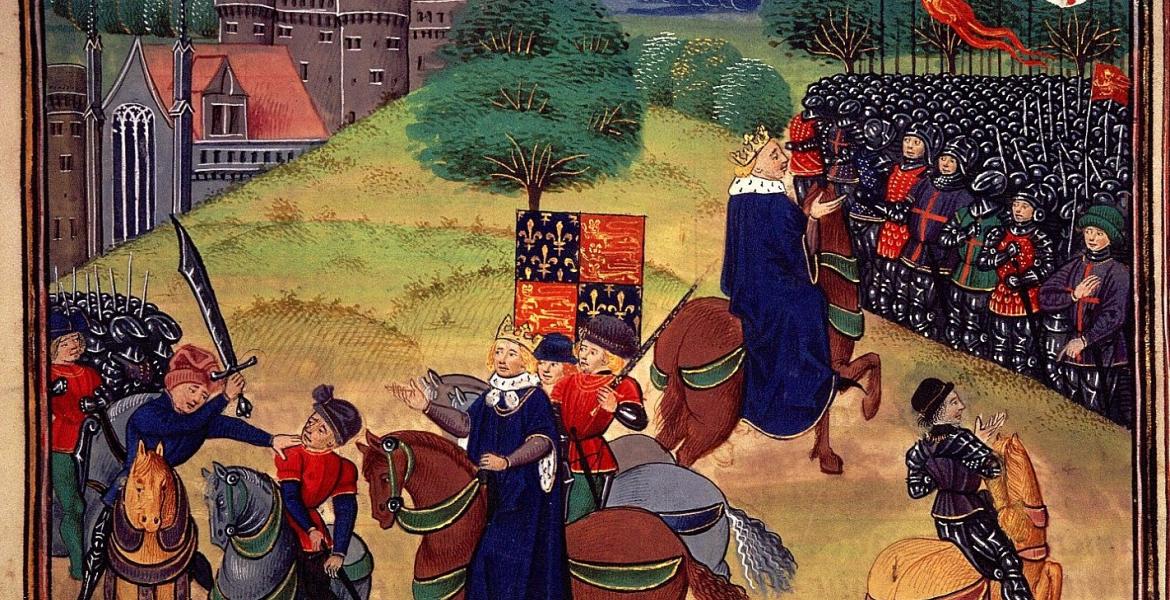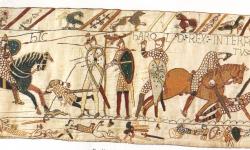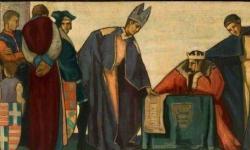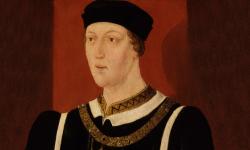The Peasants' Revolt of 1381
Key facts about the Peasants' Revolt
- The Peasants' Revolt was caused by social and economic pressures after the Black DeathA deadly disease, also known as plague, that first raised its head in its current form in the 1340s and continued ravaging communities in Europe for the next three and a half centuries.A deadly disease, also known as plague, that first raised its head in its current form in the 1340s and continued ravaging communities in Europe for the next three and a half centuries. A disease that may have been spread by the fleas of infected rats, however new evidence suggests that once the disease had infected the lungs of the malnourished it was quickly spread by sneezing and coughing, so may well have been airborne. Symptoms included painful swelling of the lymph glands,… A disease that may have been spread by the fleas of infected rats, however new evidence suggests that once the disease had infected the lungs of the malnourished it was quickly spread by sneezing and coughing, so may well have been airborne. Symptoms included painful swelling of the lymph glands,… and the wars with France.
- The 1380 poll taxAs defined in "Oxford English Dictionary" - a tax levied on every adult, without reference to their income or resources.As defined in "Oxford English Dictionary" - a tax levied on every adult, without reference to their income or resources.As defined in "Oxford English Dictionary" - a tax levied on every adult, without reference to their income or resources. As defined in "Oxford English Dictionary" - a tax levied on every adult, without reference to their income or resources. was the immediate cause.
- It started in Essex and Kent but spread quickly to other places.
- Many rebels marched on London, where they were joined by discontented Londoners.
- Rebels targeted royal officials, tax collectors, senior clergyThe people ordained for religious duties, especially in the Christian Church.The people ordained for religious duties, especially in the Christian Church. and lawyers.
- They burnt documents and several buildings.
- King Richard II met with the rebels twice. He granted their demands at the first meeting, but one of the rebel leaders was killed at the second.
- Richard II didn't keep his word and many of the rebels were punished severely.
- Although it’s known as the Peasants' Revolt, rebels included people from the towns and wealthier people.
People you need to know
- John Ball – a wandering radicalA person who advocates thorough or complete political or social reform, or a description of that change.A person who advocates thorough or complete political or social reform, or a description of that change. preacher who is known as a leader of the revolt.
- Henry Bolingbroke – John of Gaunt's son, cousin to Richard II, and the future Henry IV.
- John of Gaunt – Richard II's uncle and one of the richest men in the kingdom.
- Robert Hales – treasurer and Grand Prior of the Knights HospitallersOne of most powerful political organisations in the late Middle Ages. Their ranks were filled by the richest aristocratic families of Europe. Formed in Jerusalem in the 11th Century to provide hospital care and protection for Christian pilgrims visiting the Holy Land. Still exist today though split into many Orders.One of most powerful political organisations in the late Middle Ages. Their ranks were filled by the richest aristocratic families of Europe. Formed in Jerusalem in the 11th Century to provide hospital care and protection for Christian pilgrims visiting the Holy LandLands comprising of what is now Isreal and Palestine, including the holy land of the Jewish, Christian and Islamic religions.. Still exist today though…One of most powerful political organisations in the late Middle Ages. Their ranks were filled by the richest aristocratic families of Europe. Formed in Jerusalem in the 11th Century to provide hospital care and protection for Christian pilgrims visiting the Holy LandLands comprising of what is now Isreal and Palestine, including the holy land of the Jewish, Christian and Islamic religions.. Still exist today though… One of most powerful political organisations in the late Middle Ages. Their ranks were filled by the richest aristocratic families of Europe. Formed in Jerusalem in the 11th Century to provide hospital care and protection for Christian pilgrims visiting the Holy LandLands comprising of what is now Isreal and Palestine, including the holy landLands comprising of what is now Isreal and Palestine, including the holy land of the Jewish, Christian and Islamic religions. of the Jewish, Christian and Islamic religions.. Still exist today though… in England.
- Richard II – the boy king who was 14 years old when he met the rebels. Because he was so young, he needed advisers like John of Gaunt to help him rule.
- Simon Sudbury – Archbishop of Canterbury and chancellor.
- Wat Tyler – one of the leaders of the revolt from Kent.
- William Walworth – mayor of London.
The spring of 1381 was not an optimistic season for many in England. Social and economic shockwaves, from a plague that had swept through much of the world thirty years earlier, still reverberated around town and country alike. The treat of foreign invasion, and tensions between France and England, were ever present, and the resultant demands for more money made by the government stretched patience to the limit. And no-one trusted those in power. It was a recipe for disaster and, at the end of May 1381, all the tensions, all the stress, all the frustration, finally broke free when people across the south east of England rose to march on London and demand groundbreaking change.
Causes of the Peasants' Revolt
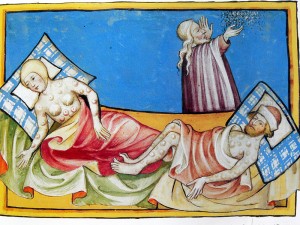
England was not a calm and quiet place at the end of the fourteenth century. The Black Death, which had wiped out at least a third of Europe’s population in just a few years, Some estimates place the death toll at around 40% to 50%, and some have even suggested it was closer to 75%, which may have been the case in individual localities. had led to significant social change. With labour in short supply, demands for more freedoms and higher wages rose, as did the spending power – and expectations – of those on the lower levels of society. The nobilityThe highest hereditary stratum of the aristocracy, sitting immediately below the monarch in terms of blood and title; or the quality of being noble (virtuous, honourable, etc.) in character. acted to protect their interests by introducing repressive measures meant to return the country to its pre-1348 status. The Statute of Labourers, introduced in 1351, not only fixed wages and prices at 1347 levels, it also extended the lords' hold over free tenants. These tenants had to swear an oath twice a year to uphold the Statute, and those who didn't could be put in the stocksA form of physical punishment and public humiliation used during in the Medieval and Early Modern periods. The stocks partially immobilised the person being punished and they were left exposed in a public place for passers by to see them.A form of physical punishment and public humiliation used during in the Medieval and Early Modern periods. The stocks partially immobilised the person being punished and they were left exposed in a public place for passers by to see them.A form of physical punishment and public humiliation used during in the Medieval and Early Modern periods. The stocks partially immobilised the person being punished and they were left exposed in a public place for passers by to see them. A form of physical punishment and public humiliation used during in the Medieval and Early Modern periods. The stocks partially immobilised the person being punished and they were left exposed in a public place for passers by to see them. . If they broke their oath they could be fined or outlawedDepriving someone of the protection of the law (so they can be hunted down and killed, for example), or banning/forbidding an object.Depriving someone of the protection of the law (so they can be hunted down and killed, for example), or banning/forbidding an object.Depriving someone of the protection of the law (so they can be hunted down and killed, for example), or banning/forbidding an object.. Furthermore, people believed there was corruption at the top levels of society. Edward III had died in 1377 and his 10-year-old grandson, Richard II, succeeded him to the throne. As Richard was so young, he needed a council of advisers, including his uncle, John of Gaunt. Few trusted this council, who were thought to be advising him badly and for their own ends.
Some estimates place the death toll at around 40% to 50%, and some have even suggested it was closer to 75%, which may have been the case in individual localities. had led to significant social change. With labour in short supply, demands for more freedoms and higher wages rose, as did the spending power – and expectations – of those on the lower levels of society. The nobilityThe highest hereditary stratum of the aristocracy, sitting immediately below the monarch in terms of blood and title; or the quality of being noble (virtuous, honourable, etc.) in character. acted to protect their interests by introducing repressive measures meant to return the country to its pre-1348 status. The Statute of Labourers, introduced in 1351, not only fixed wages and prices at 1347 levels, it also extended the lords' hold over free tenants. These tenants had to swear an oath twice a year to uphold the Statute, and those who didn't could be put in the stocksA form of physical punishment and public humiliation used during in the Medieval and Early Modern periods. The stocks partially immobilised the person being punished and they were left exposed in a public place for passers by to see them.A form of physical punishment and public humiliation used during in the Medieval and Early Modern periods. The stocks partially immobilised the person being punished and they were left exposed in a public place for passers by to see them.A form of physical punishment and public humiliation used during in the Medieval and Early Modern periods. The stocks partially immobilised the person being punished and they were left exposed in a public place for passers by to see them. A form of physical punishment and public humiliation used during in the Medieval and Early Modern periods. The stocks partially immobilised the person being punished and they were left exposed in a public place for passers by to see them. . If they broke their oath they could be fined or outlawedDepriving someone of the protection of the law (so they can be hunted down and killed, for example), or banning/forbidding an object.Depriving someone of the protection of the law (so they can be hunted down and killed, for example), or banning/forbidding an object.Depriving someone of the protection of the law (so they can be hunted down and killed, for example), or banning/forbidding an object.. Furthermore, people believed there was corruption at the top levels of society. Edward III had died in 1377 and his 10-year-old grandson, Richard II, succeeded him to the throne. As Richard was so young, he needed a council of advisers, including his uncle, John of Gaunt. Few trusted this council, who were thought to be advising him badly and for their own ends.
The threat of war with France was also a concern. A truceAn agreement between enemies to stop fighting for a limited time.An agreement between enemies to stop fighting for a limited time.An agreement between enemies to stop fighting for a limited time. An agreement between enemies to stop fighting for a limited time. with France, whom England was fighting in the Hundred Years' War, had ended in 1377, and money was once again needed to fund the military. But despite the money spent on the military, England did not have the success it had under Edward III. In the summer of 1377, the French raided towns along the coast of southern England, from Plymouth to Dover. They retook Gascony, and besieged Calais. To win the war, the government needed more money, through more taxes, and more ships, which had to be paid for and built by the people of England. The building of 31 ships was ordered of towns across England. While the main brunt of this was meant to be borne by the richest, they tried to spread the costs as widely as possible. John of Gaunt, the king's uncle, was blamed for mishandling the situation in both Spain and France for his own ends. Never popular anyway, he started to be suspected of fiddling the figures and keeping tax revenue for himself.
The building of 31 ships was ordered of towns across England. While the main brunt of this was meant to be borne by the richest, they tried to spread the costs as widely as possible. John of Gaunt, the king's uncle, was blamed for mishandling the situation in both Spain and France for his own ends. Never popular anyway, he started to be suspected of fiddling the figures and keeping tax revenue for himself. There was also a rumour that he was a changeling: the son of a Ghent butcher.
There was also a rumour that he was a changeling: the son of a Ghent butcher.
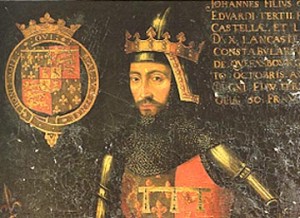
Tensions simmered below the surface, with occasional protests in the decade before the revolt. In London in 1376, a mob chased John of Gaunt and Henry Percy out of the Savoy Palace after rumours Gaunt wanted to reduce the independent powers of the City. The final straw was the poll tax, which had first been set in 1377 at 4d per adult (excluding children under 15 and 'genuine beggars'). That money was not enough, nor was the money raised in the second poll tax in 1379. The third poll tax, set in 1380, demanded a whole shillingOld British currency, before it went decimal. There were 20 shillings in a pound (£), and 12 pennies (d) in a shilling.Old British currency, before it went decimal. There were 20 shillings in a pound (£), and 12 pennies (d) in a shilling.Old British currency, before it went decimal. There were 20 shillings in a pound (£), and 12 pennies (d) in a shilling. Old British currency, before it went decimal. There were 20 shillings in a pound (£), and 12 pennies (d) in a shilling. payment from every citizen regardless of income, three times the 1377 tax. Two thirds of it was to be collected by the end of January 1381, which was outside of the usual busy agricultural periods, when workers might hope to earn additional wages. To make matters worse, it followed a particularly bad harvest and hard winter, which had stretched many further than usual. To be fair to the House of Commons, tax dues were to be assessed by area, based on a total population, and they said that the greater burden should be borne by the wealthier, within the limits that no-one should pay more than £20, nor less than 4d for a husband and wife. The CommonsPeople who weren't members of the clergy nor the nobility, or the House of Commons.People who weren't members of the clergy nor the nobility, or the House of Commons.People who weren't members of the clergy nor the nobility, or the House of Commons. also distanced themselves from the collection of the poll tax, obviously aware that it would be unpopular, and only granted £100,000 of the £160,000 asked for, suspicious that John of Gaunt was using it to fund his own military exploits in Spain. People couldn't and wouldn't pay, and there was nationwide passive resistance. Many eligible people were left off the population counts. In parts of the North Riding of Yorkshire and Devon, for example, the number of eligible taxpayers reduced by 54% between 1377 and 1381, while in Cumberland and Cornwall, numbers fell by up to 65%.
To be fair to the House of Commons, tax dues were to be assessed by area, based on a total population, and they said that the greater burden should be borne by the wealthier, within the limits that no-one should pay more than £20, nor less than 4d for a husband and wife. The CommonsPeople who weren't members of the clergy nor the nobility, or the House of Commons.People who weren't members of the clergy nor the nobility, or the House of Commons.People who weren't members of the clergy nor the nobility, or the House of Commons. also distanced themselves from the collection of the poll tax, obviously aware that it would be unpopular, and only granted £100,000 of the £160,000 asked for, suspicious that John of Gaunt was using it to fund his own military exploits in Spain. People couldn't and wouldn't pay, and there was nationwide passive resistance. Many eligible people were left off the population counts. In parts of the North Riding of Yorkshire and Devon, for example, the number of eligible taxpayers reduced by 54% between 1377 and 1381, while in Cumberland and Cornwall, numbers fell by up to 65%. Juliet Barker, England, Arise: The People, The King and the Great Revolt of 1381 (London: Abacus 2015) p.135
Juliet Barker, England, Arise: The People, The King and the Great Revolt of 1381 (London: Abacus 2015) p.135
Despite its unpopularity, the government pressed ahead with the tax even though the reasons for it – the defence of the borders with Scotland, and English lands in France – had vanished. A truce had been arranged with Scotland and a peace treaty between England’s allies and enemies in France removed the need for soldiers there. By the time the final third of the tax was being collected, the army was arriving back in England. To ensure no person escaped paying, commissioners were hired to assess each individual and household personally. Some of these assessors were said to have taken this too far, particularly in assessing the age of girls. But for the government, this reassessment was a success. Much higher numbers of people were found liable to pay, almost all of whom were poor.
The third instalment, and the money from the tax-dodgers, was due by the end of April 1381. The people of London refused to pay all they owed, and the collectors deemed it too dangerous to press for it. The first recorded violence was against a collector in Oxfordshire, William Payable, who was collecting from the clergy: the clergy were as unhappy about the poll tax as the laityPeople not belonging to the clergy.People not belonging to the clergy.People not belonging to the clergy. People not belonging to the clergy. . It was during the collection of this final amount that peasants of Fobbing and Brentwood in Essex refused to pay any more: they had already paid, and had a receipt from the commissioners to prove it. When the tax collector John Bampton ordered their arrest, the villagers drew their bows and chased him from the village. Once they had attacked royal officials performing royal duties, the villagers had no choice but to revolt. Messages and representatives were sent out to the surrounding villages where bands of rebels started to gather. The Peasants' Revolt had begun.
Aims and ambitions
The chroniclers of the time portrayed the revolt as a rabble, a violent horde that brought chaos and destruction. Yet the revolt actually seemed well organised, with - at least by the time it reached London - collective aims and ambitions. The revolt was not directed against the king, to whom the rebels remained loyal throughout. Even their watchword showed their loyalty: the response to their question 'With whom hold you?' was 'With King Richard and the true commons'. Instead, the rebellion was directed against the king's lords and advisers, especially John of Gaunt. The rebels demanded the execution of traitors, including royal officials, tax collectors and lawyers, and the abolition of 'all lordship of divers lords' except for the king.
Just as they went after official people, the rebels also targeted official documents. These were often kept in the homes of lords and other officials, which were broken into. Documents, such as the returns of the third poll tax, manorial court rolls, judicial records, and legal archives were taken and piled onto bonfires. As a result, a number of historians have seen the revolt as a war on the written record.
Above all, the rebels wanted to change society. Although the revolt was sparked by the poll tax, it was seen as a symptom of the problems in society. Several past and future tax collectors were among the rebels, so the issue wasn't just the poll tax but with society as a whole. Unlike rebellions which had come before, which focused on personal ambition and increases in power for those at the top of society, the Great Revolt sought to make society fairer for everybody. As Juliet Barker says, 'Their demands anticipated the French Revolution by four hundred years.' Barker, England, Arise, p.ix They wanted to end the restrictions placed on them by their lords and their duty to provide those lords with free labour to the manor. They wanted freedom in commerceThe activity of buying and selling of goods and services.The activity of buying and selling of goods and services.The activity of buying and selling of goods and services. and to work for whom they chose at the wages they deserved. And they wanted a 'reformed' Church, whose extensive lands and wealth would be seized by the state, and a limit placed on the number of the higher ranks of the clergy.
Barker, England, Arise, p.ix They wanted to end the restrictions placed on them by their lords and their duty to provide those lords with free labour to the manor. They wanted freedom in commerceThe activity of buying and selling of goods and services.The activity of buying and selling of goods and services.The activity of buying and selling of goods and services. and to work for whom they chose at the wages they deserved. And they wanted a 'reformed' Church, whose extensive lands and wealth would be seized by the state, and a limit placed on the number of the higher ranks of the clergy.
The revolt
Essex and Kent
The revolt spread quickly through Kent and Essex. Riders were used to carry messages across the counties, and messages were read out to villages, using official-sounding language to rouse the people. In many villages, the rebels targeted their local lords and masters. They attacked manors and church lands, seeking documents and the people they considered unjust. Some houses were looted, and some officials or nobles were threatened into giving the rebels either their possessions or their assistance. Perhaps many 'stolen' items were claimed as compensation for money or goods that the rebels considered were wrongly taken from them. In some places, auctions were arranged to buy these goods. At other places, items were destroyed along with the records, perhaps as punishment when the lord was absent.
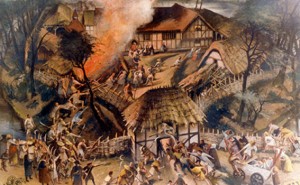
Wat Tyler assumed leadership of the Kentish rebels at Maidstone on 7 June 1381. We don't know why this was, and we know very little about him before his sudden appearance; we don't even know whether he was from Kent or Essex. Some accounts suggest that he was amongst the fathers whose daughters suffered under the tax assessors' indecent manner of deciding whether daughters were under the age of 15, although this seems more likely to have been a misreading of sources by Thomas Paine and other 18th century writers. Perhaps he was a roofer by trade (hence his surname) and some accounts say he was a notorious criminal. As Barker suggests, he may have had some military skill, as the Kentish rebels went first to Canterbury, possibly to protect their rear from attack during the march to London. Just as they did with the villages in their path, these rebels inspired the residents of Canterbury to revolt. Prisons were broken into and prisoners, including John Ball, were released.
Some accounts suggest that he was amongst the fathers whose daughters suffered under the tax assessors' indecent manner of deciding whether daughters were under the age of 15, although this seems more likely to have been a misreading of sources by Thomas Paine and other 18th century writers. Perhaps he was a roofer by trade (hence his surname) and some accounts say he was a notorious criminal. As Barker suggests, he may have had some military skill, as the Kentish rebels went first to Canterbury, possibly to protect their rear from attack during the march to London. Just as they did with the villages in their path, these rebels inspired the residents of Canterbury to revolt. Prisons were broken into and prisoners, including John Ball, were released. 
Although interestingly, we don't know from which prison Ball was released. One report is that he was rescued by a group of rebels from Essex who broke into the bishop of London's prison at Bishop's Stortford, but another report – which is usually preferred – says that he was broken out of Maidstone prison in Kent. John Ball was a dissentingHolding an opinion or belief that goes against official teaching or commonly held views.Holding an opinion or belief that goes against official teaching or commonly held views.Holding an opinion or belief that goes against official teaching or commonly held views. Holding an opinion or belief that goes against official teaching or commonly held views. priest whose preaching would later be blamed for inciting the revolt. Indeed, there is little to say how much - aside from being in Kent - he had to do with the Revolt. Although some of the goals of the rebels seemed to mirror his thinking, it is possible that he was not as essential as later chroniclers made out. There is no doubt, however, that he was troublesome to the authorities. In 1364 he had been excommunicatedTo have been punished for religious crimes, such as not being allowed to participate in any Church activities.To have been punished for religious crimes, such as not being allowed to participate in any Church activities.To have been punished for religious crimes, such as not being allowed to participate in any Church activities. To have been punished for religious crimes, such as not being allowed to participate in any Church activities. by the Archbishop of Canterbury Simon Sudbury and had a warrant put out for his arrest for teaching ideas that went against the official church. For several years he evaded the authorities, only eventually suffering arrest a few weeks before the revolt. Whatever else then, this suggests that he had friends and supporters within Essex: perhaps those very people who joined the Revolt and subsequently helped him to escape.
The march to London
Court records show that many of those who took part in local insurrectionsUprisings against a person or government in power.Uprisings against a person or government in power.Uprisings against a person or government in power. Uprisings against a person or government in power. did not march on London. Once they felt they had gained justice for the offences committed against them locally, they went back to their homes. The only member of the first group of Essex rebels who sparked the revolt who can definitely be placed in London was William Roger of South Ockendon. Others, including an Essex group led by the chaplain John Wrawe, marched north to Suffolk, to raise rebellion there. But by this point the rebellion had gained enough momentum that a formidable group remained to march from Essex and Kent towards London, and their numbers increased as those along the way joined in. In Southwark many of the locals were inspired to rebel, the Archbishop of Canterbury's manor at Lambeth Palace was sacked, and more prisons were broken into.
The only member of the first group of Essex rebels who sparked the revolt who can definitely be placed in London was William Roger of South Ockendon. Others, including an Essex group led by the chaplain John Wrawe, marched north to Suffolk, to raise rebellion there. But by this point the rebellion had gained enough momentum that a formidable group remained to march from Essex and Kent towards London, and their numbers increased as those along the way joined in. In Southwark many of the locals were inspired to rebel, the Archbishop of Canterbury's manor at Lambeth Palace was sacked, and more prisons were broken into. Simon Sudbury, forewarned of the rebel advance, had retreated to the Tower of London for protection. He was therefore not at home when the rebels attacked, destroying records and household goods, and drinking as much of his wine as they could.
Simon Sudbury, forewarned of the rebel advance, had retreated to the Tower of London for protection. He was therefore not at home when the rebels attacked, destroying records and household goods, and drinking as much of his wine as they could.
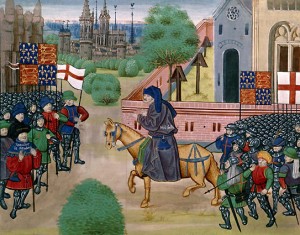
Medieval chroniclers placed the number of rebels between 60,000 and 100,000. This must be a gross exaggeration, done to make the threat of the insurrection greater. However, the force that collected just outside London, including those from the shires and the City, could well have been 10,000. This was more than most armies of the time, and certainly enough to overwhelm anything that could be called at short notice to defend the capital. Many met at Blackheath, where John Ball is alleged to have spoken to the crowd, There is no definitive proof that Ball was in London, nor that he gave a speech at Blackheath. However, two chroniclers, Walsingham and Froissart, both mention it, even though they didn't see the Blackheath meeting. beginning with the couplet:
There is no definitive proof that Ball was in London, nor that he gave a speech at Blackheath. However, two chroniclers, Walsingham and Froissart, both mention it, even though they didn't see the Blackheath meeting. beginning with the couplet:
When Adam delved and Eve span, Who then was the gentleman?
According to the same stories, he went on to question the legality of lordship and serfdomA social and economic system under the feudal system, whereby peasants owed their lord labour, theoretically in return for protection., based on stories of the Garden of EdenA Christian and Jewish story. It is a paradise that is the 'garden of God'., and encouraged those listening to restore the natural and original order of humanity. It is worth noting that serfdom was legitimised by the nobility and the Church by reference to a later verse in the Book of Genesis, which says slavery was inflicted on men as a punishment for sin. Thus, according to many Christians, slavery was a punishment ordained by God.
It is worth noting that serfdom was legitimised by the nobility and the Church by reference to a later verse in the Book of Genesis, which says slavery was inflicted on men as a punishment for sin. Thus, according to many Christians, slavery was a punishment ordained by God.
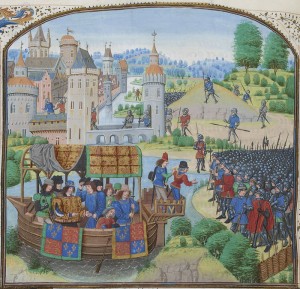
The rebels didn’t try to enter the city immediately, and while they were outside Richard II sent messages to them. A meeting was arranged at Rotherhithe, about four miles from Blackheath where the rebels were based. However, on arriving by boat, the king’s party found what seemed to be the entire rebel army waiting. They refused to land, for fear that the king would be harmed or abducted, and rowed away.
London
It is possible that this incident inspired the rebels to storm London, perhaps to force a meeting with the king. London Bridge was opened to the Kentish, and Aldgate to those from Essex. We don’t know who did this, or why. City aldermen were accused of helping the rebels enter London and some spent a brief spell in the Tower of London as a result. John Horn, Adam Karille, John Fresshe (all of whom had been instructed by the mayor, William Walworth, to ‘negotiate’ with the rebels) and Walter Sibil were accused of leaving the bridge open, and William Tonge was accused of opening Aldgate. These accusations probably were as much a case of city politics and rivalries as a statement of fact. The men were found innocent and most returned to the city elite. The only one who didn't was Horn, who may have had more to do with the rebellion. There were certainly sympathisers within the City, and several sources state that city dwellers allowed the rebels to come and go as they pleased.
John Horn, Adam Karille, John Fresshe (all of whom had been instructed by the mayor, William Walworth, to ‘negotiate’ with the rebels) and Walter Sibil were accused of leaving the bridge open, and William Tonge was accused of opening Aldgate. These accusations probably were as much a case of city politics and rivalries as a statement of fact. The men were found innocent and most returned to the city elite. The only one who didn't was Horn, who may have had more to do with the rebellion. There were certainly sympathisers within the City, and several sources state that city dwellers allowed the rebels to come and go as they pleased.
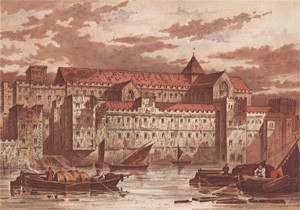
Although we don’t know the exact route the rebels took once they entered London, or whether they went as one big group or several smaller groups, we do know where they attacked during the night of 13 June 1381. One of the first places they visited was the palace at the Savoy belonging to John of Gaunt. Although it’s possible the attack on the Savoy Palace began before the rebels reached it, suggesting Londoners were responsible. Gaunt was away negotiating a truce with Scotland, and so avoided the fate of his home, which has destroyed so completely that it was never rebuilt. Everything in it that wouldn’t burn was broken and thrown into the Thames or the sewers. Records suggest the total loss of goods (not the building) from the Savoy Palace was £10,000. Thievery was not allowed, and the rebels took care of thieves themselves: one caught stealing silver was said to have ended up in the flames along with his bootyValuable stolen goods, especially those seized in war.Valuable stolen goods, especially those seized in war.Valuable stolen goods, especially those seized in war. Valuable stolen goods, especially those seized in war. ; and thirty-two who were drunk on Gaunt’s wine were trapped and killed when the cellar collapsed. Other buildings were targeted throughout London. The provincial headquarters of the Knights Hospitaller, the priory of St John of Jerusalem, was sacked and destroyed.
Although it’s possible the attack on the Savoy Palace began before the rebels reached it, suggesting Londoners were responsible. Gaunt was away negotiating a truce with Scotland, and so avoided the fate of his home, which has destroyed so completely that it was never rebuilt. Everything in it that wouldn’t burn was broken and thrown into the Thames or the sewers. Records suggest the total loss of goods (not the building) from the Savoy Palace was £10,000. Thievery was not allowed, and the rebels took care of thieves themselves: one caught stealing silver was said to have ended up in the flames along with his bootyValuable stolen goods, especially those seized in war.Valuable stolen goods, especially those seized in war.Valuable stolen goods, especially those seized in war. Valuable stolen goods, especially those seized in war. ; and thirty-two who were drunk on Gaunt’s wine were trapped and killed when the cellar collapsed. Other buildings were targeted throughout London. The provincial headquarters of the Knights Hospitaller, the priory of St John of Jerusalem, was sacked and destroyed. Its prior, who was also treasurer of England, Robert Hales, escaped the rebels at the priory, only to be executed at Tower Hill the following day. The gaols at Newgate, Westminster, Fleet and Marshalsea were broken into and their inmates released, which swelled the numbers of the crowd. The Temple, home of English law and lawyers, was sacked, with documents burned.
Its prior, who was also treasurer of England, Robert Hales, escaped the rebels at the priory, only to be executed at Tower Hill the following day. The gaols at Newgate, Westminster, Fleet and Marshalsea were broken into and their inmates released, which swelled the numbers of the crowd. The Temple, home of English law and lawyers, was sacked, with documents burned.
People, as well as buildings, were attacked during the revolt. But, like the buildings in question, the violence generally targeted those thought to have harmed the commoners. Many were lawyers, such as the Chief Justice of the King’s Bench. Others were tax collectors, royal officials and members of the higher clergy. Some victims sought refuge in churches but were dragged out and executed, a blasphemous act and a huge breach of religious protocol.
Mile End
With violence and destruction escalating, attempts were made to promise the rebels pardons and a fair hearing for their complaints, if only they would go home. When this didn't work, Richard II rode out to meet them at Mile End on 14 June 1381. He left many of his advisers, including Simon Sudbury, Robert Hales, and his cousin, the son of John of Gaunt, Henry Bolingbroke, hiding in the Tower. This 14-year-old boy confronted the rebels and asked what they wanted. They replied with a list of demands, including an end to feudalismA Medieval social structure where, in theory, the nobility would protect everyone, the peasants would pay for this protection by working the land, and the clergy would pray for everyone. In the secular world, the monarch was at the top of the pyramid, with each layer of nobility and commons owing services or favour to the layers above and below them., for traitors to be punished, the abolition of all laws apart from those of Winchester, This phrase has prompted much discussion, but little understanding. The laws referred to could be those of Alfred the Great, or they possibly referred to the Domesday BookThe two-million-word report of the survey commissioned by William the Conqueror into land-holding and worth in England and parts of Wales. Its name comes from the a reference to the final account at the Last Judgement, as it was such a complete record.The two-million-word report of the survey commissioned by William the Conqueror into land-holding and worth in England and parts of Wales. Its name comes from the a reference to the final account at the Last Judgement, as it was such a complete record.The two-million-word report of the survey commissioned by William the Conqueror into land-holding and worth in England and parts of Wales. Its name comes from the a reference to the final account at the Last Judgement, as it was such a complete record. The two-million-word report of the survey commissioned by William the Conqueror into land-holding and worth in England and parts of Wales. Its name comes from the a reference to the final account at the Last Judgement, as it was such a complete record. , which was sometimes called 'the book of Winchester', or to the 1285 Statute of Winchester, which set the ideal of community self-policing. for church lands to be confiscated for the benefit of the people, and for a general pardon issued to all those included in the revolt. The king granted most of their demands (although the Statute of Labourers was to remain in place), and set scribes to writing the relevant letters immediately. The Anonimalle Chronicle
This phrase has prompted much discussion, but little understanding. The laws referred to could be those of Alfred the Great, or they possibly referred to the Domesday BookThe two-million-word report of the survey commissioned by William the Conqueror into land-holding and worth in England and parts of Wales. Its name comes from the a reference to the final account at the Last Judgement, as it was such a complete record.The two-million-word report of the survey commissioned by William the Conqueror into land-holding and worth in England and parts of Wales. Its name comes from the a reference to the final account at the Last Judgement, as it was such a complete record.The two-million-word report of the survey commissioned by William the Conqueror into land-holding and worth in England and parts of Wales. Its name comes from the a reference to the final account at the Last Judgement, as it was such a complete record. The two-million-word report of the survey commissioned by William the Conqueror into land-holding and worth in England and parts of Wales. Its name comes from the a reference to the final account at the Last Judgement, as it was such a complete record. , which was sometimes called 'the book of Winchester', or to the 1285 Statute of Winchester, which set the ideal of community self-policing. for church lands to be confiscated for the benefit of the people, and for a general pardon issued to all those included in the revolt. The king granted most of their demands (although the Statute of Labourers was to remain in place), and set scribes to writing the relevant letters immediately. The Anonimalle Chronicle A 14th century chronicle written by an anonymous author records ‘The king granted that they should freely seize all who were traitors and could be proved to be such by process of law’.
A 14th century chronicle written by an anonymous author records ‘The king granted that they should freely seize all who were traitors and could be proved to be such by process of law’. R.B. Dobson, The Peasants' Revolt of 1381, (London: Macmillan 1970) p.161 He sealed the letters with the Great SealA seal used for the authentication of state documents of the highest importance.A seal used for the authentication of state documents of the highest importance. , giving them the mark of law. Many rebels, carrying what they considered to be the king’s blessing, returned to their own areas to carry out the sentence.
R.B. Dobson, The Peasants' Revolt of 1381, (London: Macmillan 1970) p.161 He sealed the letters with the Great SealA seal used for the authentication of state documents of the highest importance.A seal used for the authentication of state documents of the highest importance. , giving them the mark of law. Many rebels, carrying what they considered to be the king’s blessing, returned to their own areas to carry out the sentence.
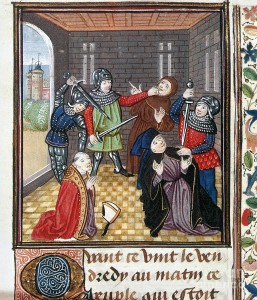
At some point during or after the Mile End meeting, rebels entered the Tower of London, arrested Sudbury and Hales, and executed them on Tower Hill. Some chroniclers and historians say the incident happened during the Mile End meeting. Others, such as the Anonimalle Chronicle and the London letter-books, suggest it happened after Richard had given his permission for traitors to be seized. Their heads were put on spikes and displayed on Tower Bridge, a typical punishment for traitors. It seems unlikely that the rebels broke into the Tower without help: it cannot be stormed, certainly not in the space of a few hours by a lightly armed ‘mob’. Its design, built to withstand heavy military bombardment, absolutely prevents a group of just 400 men from entering against the wishes its defenders. So, either the rebels had inside help, or they were bearing proof that they were acting in the king’s name. When they were given entry, they arrested only five of those inside, and did very little damage - hardly the actions of a crazed mob. Aside from Hales and Sudbury, the victims included the king’s sergeant-at-arms, John Legge, who had gained a name for himself during the re-assessment for the poll tax; a much-favoured physician of John of Gaunt, the Franciscan friar William Appleton;
Some chroniclers and historians say the incident happened during the Mile End meeting. Others, such as the Anonimalle Chronicle and the London letter-books, suggest it happened after Richard had given his permission for traitors to be seized. Their heads were put on spikes and displayed on Tower Bridge, a typical punishment for traitors. It seems unlikely that the rebels broke into the Tower without help: it cannot be stormed, certainly not in the space of a few hours by a lightly armed ‘mob’. Its design, built to withstand heavy military bombardment, absolutely prevents a group of just 400 men from entering against the wishes its defenders. So, either the rebels had inside help, or they were bearing proof that they were acting in the king’s name. When they were given entry, they arrested only five of those inside, and did very little damage - hardly the actions of a crazed mob. Aside from Hales and Sudbury, the victims included the king’s sergeant-at-arms, John Legge, who had gained a name for himself during the re-assessment for the poll tax; a much-favoured physician of John of Gaunt, the Franciscan friar William Appleton; Appleton seems to have been executed because of his connection with Gaunt and a petty lawyer, Richard Somenour of Stepney, who had been targeted by the rebels and sought protection in the Tower.
Appleton seems to have been executed because of his connection with Gaunt and a petty lawyer, Richard Somenour of Stepney, who had been targeted by the rebels and sought protection in the Tower. The future Henry IV might have made a sixth victim, but for the actions of a guard who hid him in a closet. The King’s bed was shredded by the rebels, which could be seen as a wanton act of destruction, although Barker argues this was more of an attack on the private audiences held by the King, rather than on the King’s property per se.
The future Henry IV might have made a sixth victim, but for the actions of a guard who hid him in a closet. The King’s bed was shredded by the rebels, which could be seen as a wanton act of destruction, although Barker argues this was more of an attack on the private audiences held by the King, rather than on the King’s property per se.
Whatever happened in the Tower of London, the executions seemed to spark an increase in violence. Immigrant FlemingsA native of Flanders or those speaking the Flemish language from northern and western Belgium., who attracted suspicion and jealousy, were targeted, with scores killed. Many were dragged from churches and executed on the streets. With this increase and with many rebels unwilling to return home, the remaining government became desperate. A proclamationA public or official announcement dealing with a matter of great importanceA public or official announcement dealing with a matter of great importanceA public or official announcement dealing with a matter of great importance A public or official announcement dealing with a matter of great importance was made threatening that Gaunt would return from Scotland at the head of an army of 20,000 men. When this didn't have the desired effect, Richard again suggested meeting with the rebels, this time at Smithfield.
Many were dragged from churches and executed on the streets. With this increase and with many rebels unwilling to return home, the remaining government became desperate. A proclamationA public or official announcement dealing with a matter of great importanceA public or official announcement dealing with a matter of great importanceA public or official announcement dealing with a matter of great importance A public or official announcement dealing with a matter of great importance was made threatening that Gaunt would return from Scotland at the head of an army of 20,000 men. When this didn't have the desired effect, Richard again suggested meeting with the rebels, this time at Smithfield.
Smithfield
On 15 June 1381, Wat Tyler and Richard II met for the second time. The king asked Tyler why the rebels didn’t go home, and Tyler asked for further concessions. We don’t know what happened next, or what Tyler did to provoke a reaction, but it seems he did something to offend the king. His arrest was ordered (by either Richard or William Walworth), and in response Tyler tried to stab Walworth, who was protected by armour underneath his cloak. Walworth struck back with a dagger blow to the head, knocking Tyler off his horse, and one of the king’s esquires, Ralph Standissh, killed Tyler with his sword.
In the confusion that followed, the rebels looked ready to draw their bows, and thus release an indiscriminate rain of death on the king and his advisers. But Richard, in an act of magnificent valourShowing great courage in the face of danger., rode towards them and declared himself their captain. He asked them to think about what they were doing, and to leave peacefully. They were to leave their banners and letters, but the pardons would be honoured. Astonishingly, the rebels obeyed.
Astonishingly, the rebels obeyed.
One of the biggest questions about that day was whether the murder of Wat Tyler was planned, and if so, if it was by Richard, or someone else. If it was planned, it was a risky strategy, with armed and angry rebels not far away. Tyler’s death almost destroyed the king’s party, and it was only the quick thinking of Richard that prevented it. Would Richard or his advisers really have risked it on purpose? However, if the reports of some chroniclers that there was a militia on standby were true, then this might make a pre-planned attack on Tyler more likely. And given that all of the king’s party were rewarded for their actions - Richard knighted those, including Walworth and Standissh, who were not already knights and gave other rewards to those who already were - it would seem that Tyler's death was, at the least, a very welcome surprise.
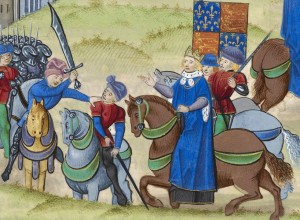
A countrywide rebellion
It is generally thought that the revolt happened just in the south and east of the country, with the main events centring on London. Although it did start in Essex and Kent, and London, being the capital, bore the brunt of it, the revolt was by no means limited to this area. On 23 and 24 June, royal writs were issued demanding the rebels to be resisted, arrested, and punished in York, Bridgwater, Beverley, Scarborough, Kingston-upon-Hull, Newcastle-upon-Tyne, Bath, Bristol and Oxford.
Many of these rebellions were inspired by the same issues that had caused the initial revolt in Essex, and also sought to address long-standing feuds between the townspeople and their perceived oppressors, be they members of the clergy or powerful and corrupt local officials. It is possible that many of these later outbreaks were directly caused by Richard’s letters, written at Mile End, and which legitimised the acts of the rebels. Perhaps, then, if Richard had not written the letters, or if he had withdrawn his support earlier, then many of those involved in these outbreaks would not have joined in, and the country would have been spared much of the revolt.
Repercussions
Wat Tyler wasn't the only rebel to be summarily executedexecuted without a trial.executed without a trial.executed without a trial. executed without a trial. in the following days and months. The government, keen to discourage anyone from rebelling again, set up commissions across the country to try, and execute, rebel leaders. The letters of pardon were ignored, even before Richard formally revoked them on 2 July 1381. But many rebels weren't given a trial and were killed while fleeing or, in one case, when handing in a petition. Nor could those brought to trial expect any better. The commissions, although technically forming proper and fair courts of law, were for much of the country anything but. Many of the victims of the revolt sat on these commissions, and often acted as prosecution and judge. Several of the accused were illegally tried for treason, even though the definition didn't apply. Punishment could be severe, with hundreds being executed. John Ball was convicted on very scanty evidence and hanged, drawn and quartered in the presence of the king on 15 July 1381. Nothing was proved about his whereabouts during the revolt, and he was convicted on the basis that some letters he had written were found in a rebel’s pocket. His main crime seems to have been his criticism of those who abused their power. The Monk of Westminster recorded that:
The letters of pardon were ignored, even before Richard formally revoked them on 2 July 1381. But many rebels weren't given a trial and were killed while fleeing or, in one case, when handing in a petition. Nor could those brought to trial expect any better. The commissions, although technically forming proper and fair courts of law, were for much of the country anything but. Many of the victims of the revolt sat on these commissions, and often acted as prosecution and judge. Several of the accused were illegally tried for treason, even though the definition didn't apply. Punishment could be severe, with hundreds being executed. John Ball was convicted on very scanty evidence and hanged, drawn and quartered in the presence of the king on 15 July 1381. Nothing was proved about his whereabouts during the revolt, and he was convicted on the basis that some letters he had written were found in a rebel’s pocket. His main crime seems to have been his criticism of those who abused their power. The Monk of Westminster recorded that:
The royal judges were now everywhere to be seen in session, inquiring into the activities of the conspirators and giving the guilty short shrift. Gibbets rose where none had been before, since existing ones were too few for the bodies of the condemned. Many who had been privy to the insurrection took to flight to avoid sharing the arrest and bitter fate suffered by others.Quoted in Barker, England, Arise, p.372
A general pardon was eventually made available to the rebels, but it had to be bought by each individual, after they had admitted to involvement in the rebellion. Dan Jones says this was done in response to a petition from Parliament, who feared another insurrection as a result of the persecutions (‘The Peasants' Revolt, 1381' in History Today 59, 2009). Over 200 leaders and those considered to have committed terrible crimes were excluded from the pardon. Victims of the revolt were also able to receive compensation or the return of their goods directly from those responsible, allowing them to skip the normal judicial process. This led to corruption, with people naming those they disliked or using the opportunity to get more than they lost. One bishop accused six hundred people of stealing from him. The situation became so bad this right was withdrawn and normal judicial procedure resumed.
Dan Jones says this was done in response to a petition from Parliament, who feared another insurrection as a result of the persecutions (‘The Peasants' Revolt, 1381' in History Today 59, 2009). Over 200 leaders and those considered to have committed terrible crimes were excluded from the pardon. Victims of the revolt were also able to receive compensation or the return of their goods directly from those responsible, allowing them to skip the normal judicial process. This led to corruption, with people naming those they disliked or using the opportunity to get more than they lost. One bishop accused six hundred people of stealing from him. The situation became so bad this right was withdrawn and normal judicial procedure resumed.
Although the Peasants' Revolt has been hailed as the beginning of the end of feudalism, it is unlikely it had any direct effect at all. VilleinageA form of serfdom under the feudal system, whereby peasants were free, but restricted in their movements and options by their lord, to whom they owed labour and services. In theory, the lord in return was meant to look after the wellbeing of the villein.A form of serfdom under the feudalOf, or relating to, a Medieval social structure where, in theory, the nobility would protect everyone, the peasants would pay for this protection by working the land, and the clergy would pray for everyone. In the secular world, the monarch was at the top of the pyramid, with each layer of nobility and commons owing services or favour to the layers above and below them. Although the term relates to the Middle Ages, it was not actually coined until the 16th century, so some medievalists don't like it. system, whereby peasants were free, but restricted in their movements and options by their lord, to whom they owed labour and services. In theory, the lord in return was meant to look after the wellbeing of the villein.A form of serfdom under the feudal system, whereby peasants were free, but restricted in their movements and options by their lord, to whom they owed labour and services. In theory, the lord in return was meant to look after the wellbeing of the villein. A form of serfdom under the feudal system, whereby peasants were free, but restricted in their movements and options by their lord, to whom they owed labour and services. In theory, the lord in return was meant to look after the wellbeing of the villein. did in the end die out, although it was never officially abolished and continued into the Tudor period: Elizabeth I sold off some of her villeinsA feudal tenant entirely subject to a lord or manor to whom he paid dues and services in return.A feudal tenant entirely subject to a lord or manor to whom he paid dues and services in return.A feudal tenant entirely subject to a lord or manor to whom he paid dues and services in return. A feudal tenant entirely subject to a lord or manor to whom he paid dues and services in return. to raise money. However, more and more tenants refused to undertake the work expected of them, or refused to take up tenancies with labour dues attached. This, combined with economic pressures such as a drop in the price of grain, meant more and more tenants would become ‘free’. John Ball’s role in the revolt led to a tightening by the church on wandering preachers and potential heresyA belief or opinion that goes against the official Church doctrine., which had an impact on movements such as the LollardsFollowers of John Wyclif, who believed that the Church should promote - and follow - a life of poverty. They were considered part of a heretical movement and were popular between the late 14th century and the Reformation.. LollardyA heretical religious movement popular between the late 14th century and the Reformation that questioned the wealth of the Church and its teachings.A heretical religious movement popular between the late 14th century and the ReformationThe split from the Roman Catholic Church of protestants, inspired by people such as Martin Luther, John Calvin, and Huldrych Zwingli. that questioned the wealth of the Church and its teachings.A heretical religious movement popular between the late 14th century and the Reformation that questioned the wealth of the Church and its teachings. A heretical religious movement popular between the late 14th century and the Reformation that questioned the wealth of the Church and its teachings. was a heretical religious movement popular between the late 14th century and the Reformation The split from the Roman Catholic Church of protestants, inspired by people such as Martin Luther, John Calvin, and Huldrych Zwingli. that questioned the wealth of the Church and its teachings. Ironically, the patronA person who gives financial or other support to a client, person, organisation, or cause.A person who gives financial or other support to a client, person, organisation, or cause. of John Wycliffe (who had inspired Lollardy) was John of Gaunt. This in turn led to the introduction in 1401 of burning at the stake as a punishment for heresy. Perhaps the biggest effect the revolt had was that it would be over 600 years before another poll tax was levied.
LollardyA heretical religious movement popular between the late 14th century and the Reformation that questioned the wealth of the Church and its teachings.A heretical religious movement popular between the late 14th century and the ReformationThe split from the Roman Catholic Church of protestants, inspired by people such as Martin Luther, John Calvin, and Huldrych Zwingli. that questioned the wealth of the Church and its teachings.A heretical religious movement popular between the late 14th century and the Reformation that questioned the wealth of the Church and its teachings. A heretical religious movement popular between the late 14th century and the Reformation that questioned the wealth of the Church and its teachings. was a heretical religious movement popular between the late 14th century and the Reformation The split from the Roman Catholic Church of protestants, inspired by people such as Martin Luther, John Calvin, and Huldrych Zwingli. that questioned the wealth of the Church and its teachings. Ironically, the patronA person who gives financial or other support to a client, person, organisation, or cause.A person who gives financial or other support to a client, person, organisation, or cause. of John Wycliffe (who had inspired Lollardy) was John of Gaunt. This in turn led to the introduction in 1401 of burning at the stake as a punishment for heresy. Perhaps the biggest effect the revolt had was that it would be over 600 years before another poll tax was levied. When Thatcher tried to introduce the poll tax in 1990, there was also widespread discontent and rioting.
When Thatcher tried to introduce the poll tax in 1990, there was also widespread discontent and rioting.
Did Richard support the rebels?
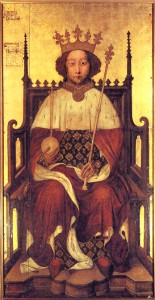
We don’t know what Richard thought about the rebels, but we do know that he granted their demands, wrote official letters empowering the rebels, and then revoked this power over two weeks later. Does this mean that he supported them, and then changed his mind? Or was the support just a show to make the rebels leave?
The chroniclers of the day, and most modern historians, think that Richard agreed to the rebels’ demands under duress, that he never meant them and just wanted to end the rebellion. After all, Wat Tyler and other rebels were killed, and Richard did in the end withdraw his support. But if this was the case, why did it take him so long to cancel the letters? Perhaps he was busy with reducing the rebellion in the counties, and didn't have time to think about them? Or maybe, as Barker suggests, this delay was because Richard was reluctant either to go back on his word or to end his support for reform. His concern for the rebel cause could perhaps be seen when he questioned parliament in November 1381 on whether he had been right to withdraw his support. Unsurprisingly, with so many vested interests, the unanimous answer (after some debate with the lords) was ‘yes’. He also established a commission to consider the causes of the revolt, in order to prevent a similar situation from happening again. The report failed to address the primary social concerns raised in the revolt, such as villeinageA form of serfdom under the feudal system, whereby peasants were free, but restricted in their movements and options by their lord, to whom they owed labour and services. In theory, the lord in return was meant to look after the wellbeing of the villein.A form of serfdom under the feudal system, whereby peasants were free, but restricted in their movements and options by their lord, to whom they owed labour and services. In theory, the lord in return was meant to look after the wellbeing of the villein.. Instead, it concentrated on the corruption of some officials, and urged for greater integrity.Yet royal commissions to punish the rebels were organised within days of the Smithfield meeting. If Richard favoured the rebels, then surely this wouldn't have been the case. Furthermore, Richard is meant to have said to a group of rebels:
The report failed to address the primary social concerns raised in the revolt, such as villeinageA form of serfdom under the feudal system, whereby peasants were free, but restricted in their movements and options by their lord, to whom they owed labour and services. In theory, the lord in return was meant to look after the wellbeing of the villein.A form of serfdom under the feudal system, whereby peasants were free, but restricted in their movements and options by their lord, to whom they owed labour and services. In theory, the lord in return was meant to look after the wellbeing of the villein.. Instead, it concentrated on the corruption of some officials, and urged for greater integrity.Yet royal commissions to punish the rebels were organised within days of the Smithfield meeting. If Richard favoured the rebels, then surely this wouldn't have been the case. Furthermore, Richard is meant to have said to a group of rebels:
Rustics you were and rustics you are still; you will remain in bondage, not as before but incomparably harsher. For as long as we live and, by God’s grace, rule over the realm, we will strive with mind, strength and goods to suppress you so that the rigour of your servitude will be an example to posterity.Quoted in David Horspool, The English Rebel: One Thousand Years of Trouble-making from the Normans to the Nineties, London: Penguin (2009) p.135
This doesn't seem to show much sympathy. As Barker points out, though, this tirade was recorded by Walsingham, who famously made up other speeches. Even if the strength of Richard’s words was exaggerated to fit with the lords wishes, it seems unlikely the sentiment was entirely wrong: it would not have been wise to lie about the king’s words.
As Barker points out, though, this tirade was recorded by Walsingham, who famously made up other speeches. Even if the strength of Richard’s words was exaggerated to fit with the lords wishes, it seems unlikely the sentiment was entirely wrong: it would not have been wise to lie about the king’s words.
In 1381, Richard was still a boy. Even if he favoured the rebel cause, parliament and his advisers had made it clear that they would never abandon villeinage, as it was in their interests to keep it. Maybe he was overruled by these people. In his later years, this is something he would do less and less, which eventually led to his usurpationThe taking of someone's power or property by force.The taking of someone's power or property by force.The taking of someone's power or property by force. The taking of someone's power or property by force. by his cousin, Henry Bolingbroke. Certainly both Barker and David Horspool agree Richard's character changed after the revolt, and that he learnt lessons from it. The young Richard must have been impressed that by sheer force of his personality he had managed to contain the revolt. This, surely, gave him ideas about the divine right of kings. Later, he would use parliament less and less and would instead rely on a few close friends, whom he promoted personally. Perhaps, by the time he was old enough to rule alone, he had had enough of being overruled by his advisers.
Were the peasants really revolting?
Our view of the Peasants' Revolt is coloured by the people who wrote about it, as well as by the views of our own society. Even the name of the revolt has been affected. The term 'the Peasants' Revolt' suggests the rebels were all poor, and all from the countryside. Its name came about during the nineteenth and twentieth centuries, ContemporarySomeone or something living or occurring at the same time.Someone or something living or occurring at the same time.Someone or something living or occurring at the same time. Someone or something living or occurring at the same time. chroniclers called it, among other things, 'the great' or 'diabolical insurrection'. The Bermondsey chronicler called it 'the common people against the nobles of the kingdom of England, which is called "the Hurling".' (Barker, England, Arise, p.xiv) when Marxist historiansHistorians, usually writing during the 20th century, who follow a Marxist ideology, and who usually view history as an economic and social battle between classes.Historians, usually writing during the 20th century, who follow a Marxist ideologyA system of ideas and ideals., and who usually view history as an economic and social battle between classes.Historians, usually writing during the 20th century, who follow a Marxist ideologyA system of ideas and ideals. , and who usually view history as an economic and social battle between classes. Historians, usually writing during the 20th century, who follow a Marxist ideology, and who usually view history as an economic and social battle between classes. wrote history through their own economic viewpoint, which saw the rebels as a down-trodden economic group rising up against their oppressors. In reality, it was a complicated process with complicated origins, and the name is now starting to fall out of use.
ContemporarySomeone or something living or occurring at the same time.Someone or something living or occurring at the same time.Someone or something living or occurring at the same time. Someone or something living or occurring at the same time. chroniclers called it, among other things, 'the great' or 'diabolical insurrection'. The Bermondsey chronicler called it 'the common people against the nobles of the kingdom of England, which is called "the Hurling".' (Barker, England, Arise, p.xiv) when Marxist historiansHistorians, usually writing during the 20th century, who follow a Marxist ideology, and who usually view history as an economic and social battle between classes.Historians, usually writing during the 20th century, who follow a Marxist ideologyA system of ideas and ideals., and who usually view history as an economic and social battle between classes.Historians, usually writing during the 20th century, who follow a Marxist ideologyA system of ideas and ideals. , and who usually view history as an economic and social battle between classes. Historians, usually writing during the 20th century, who follow a Marxist ideology, and who usually view history as an economic and social battle between classes. wrote history through their own economic viewpoint, which saw the rebels as a down-trodden economic group rising up against their oppressors. In reality, it was a complicated process with complicated origins, and the name is now starting to fall out of use.
It was not always the poorest who were involved in the revolt: many rebels were from the squeezed middle classes, overburdened helping their neighbours pay the poll tax. They included members of the clergy, such as the vicar of Ware Philip of Hertford, lesser members of the nobility, and landholders who hand been treated badly in the courts. People like Thomas atte Raven, the former MP for Rochester, were 'principal and chief malefactorSomeone who commits a crime or other wrongful deed.[s]', leading Kentish rebels through Southwark, targeting prisons (including England’s oldest prison, the Clink), and the houses of jurors and professional informers.
Nor were all of the protesters from the countryside: a large number of Londoners – as well as those from other towns – took part in the revolt. Following the revolt, more Londoners were excluded from the right to claim a pardon than those from Kent and Essex. As such, it is not possible to name it as a peasants’ revolt. Although protesters from Kent and Essex might have sparked the revolt in London, there had already been unrest in London – directed particularly at John of Gaunt – during the previous decade. And these Londoners weren't all downtrodden, but were goldsmiths and innkeepers, craftsmen and artisans, and even William Brampton, the gatekeeper of Cripplegate.
Just as we have a narrow view of those involved in the revolt, so we have a limited understanding of their actions. The accounts of the revolt were written by the victors, most of whom were clerics and all of whom felt their place in the world had been threatened. The chroniclers focused on unrestrained violence and theft, and their language is chosen to support this. But there is a lot of evidence to suggest the Peasants' Revolt wasn’t simply a rabble and a mob. They used written proclamations, Whether this is because someone within the rebellion had the experience and knowledge to write these proclamations independently, or whether they were utilising the skills of one of the gentryThe social rung below the nobility, but including those who were landed and entitled to a coat of arms, and who could sit in the House of Commons. It typically included the locally powerful, such as knights and other important people in towns and the counties.The social rung below the nobility, but including those who were landed and entitled to a coat of arms, and who could sit in the House of Commons. It typically included the locally powerful, such as knights and other important people in towns and the counties. they captured, we do not know. We also don't know how far these captured nobles were forced into working with the rebellion or how far they sympathised with it. they seemed to have some strategy in deciding their targets, and generally they showed restraint in their behaviour. Many people might well have thought they were operating within the law, which is understandable given Richard's show of support for the rebel demands. Furthermore, the language of the law, which was always focused towards the better-off, and which can still be seen in the court records, accentuates this. So 'with force and arms', a common phrase associated with the revolt, does not always mean with violence. It can simply be the act of entering someone's property uninvited, by, for example, jumping a wall. There was obviously some aspect of violence and theft, as there is in any demonstration, no matter how peaceful its aims, but it’s that 10 per cent that ‘spoil it for the rest of us’.
Whether this is because someone within the rebellion had the experience and knowledge to write these proclamations independently, or whether they were utilising the skills of one of the gentryThe social rung below the nobility, but including those who were landed and entitled to a coat of arms, and who could sit in the House of Commons. It typically included the locally powerful, such as knights and other important people in towns and the counties.The social rung below the nobility, but including those who were landed and entitled to a coat of arms, and who could sit in the House of Commons. It typically included the locally powerful, such as knights and other important people in towns and the counties. they captured, we do not know. We also don't know how far these captured nobles were forced into working with the rebellion or how far they sympathised with it. they seemed to have some strategy in deciding their targets, and generally they showed restraint in their behaviour. Many people might well have thought they were operating within the law, which is understandable given Richard's show of support for the rebel demands. Furthermore, the language of the law, which was always focused towards the better-off, and which can still be seen in the court records, accentuates this. So 'with force and arms', a common phrase associated with the revolt, does not always mean with violence. It can simply be the act of entering someone's property uninvited, by, for example, jumping a wall. There was obviously some aspect of violence and theft, as there is in any demonstration, no matter how peaceful its aims, but it’s that 10 per cent that ‘spoil it for the rest of us’.
Things to think about
- Did the Peasants' Revolt have any effect on society?
- Is the Peasants' Revolt the best name for it?
- Were the peasants really revolting: was it just a mob, or was it a more organised rebellion?
- Did Richard II sympathise with the rebels, and were his letters a genuine reflection of what he wanted?
- What really happened at Smithfield?
Things to do
- There are few places associated with the revolt that show any sign of it now. The one place a memorial has been established is on the northern wall of St Bart's Hospital, Smithfield.
- The revolt wasn't just confined to London. See if you can find any local records on whether on not your town was involved in the uprising.
Further Reading
Without a doubt, the best recent book on the Peasants' Revolt is Juliet Barker's, England, Arise: The People, The King and the Great Revolt of 1381 (2015). It is, however, quite in-depth and rather academic.
- Log in to post comments


